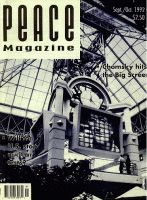
Peace Magazine Sep-Oct 1992, page 12. Some rights reserved.
Search for other articles by William Klassen here
Simon Wiesenthal once remarked that for a Jew to be realistic is to believe in miracles. The same could be said of Christians and Muslims.
Anyone who works for peace must be prepared for the unpredictable, or the miraculous. In 1974 when I returned to Canada from a year's research in Jerusalem, no one could have foreseen Sadat's bold peace initiative so soon after he had led the Arab nations in a war against Israel. The peace treaty between Egypt and Israel, whatever its limitations, continues to shine as a beacon of hope in an otherwise dark situation. Again who would have predicted that within a week of the installation of the new government in Israel, Prime Minister Rabin would be in Cairo and that new settlements would be halted?
The deepest struggle for peace in the Middle East comes not from the differences between Muslims and Jews or Jews and Christians. Potentially, the most dangerous struggle is the one between tolerance and intolerance, acceptance and rejection, which takes place within each of the large religious communities- Judaism, Islam, and Christianity-in the Middle East.
In Judaism there are various groups. On the far left there are many Jews to whom religion has little or no meaning. Proud of their liberal secularism, some are atheists and some are Zionists affirming a national home for Jews. On the far right are the Haredim, some of whom have no use for an Israeli state, while others are passionately committed to it. They share a fervent passion for their religion. And in the middle are all varieties and shades of differences. These groups all unite when war is declared against Israel, but the strength of their peace movements should not be ignored or underestimated.
Peace Now has demonstrated a very strong commitment to peace and justice and has marshalled hundreds of thousands of people into the streets to protest massacres of Palestinians in refugee camps and other atrocities.
Groups like Oz ve Shalom and There is a Limit, although small, lead the struggle to combine religion and peace, and insist that truly religious people will not kill their fellows. They affirm peace through strength, but strength is not seen by them in predominantly military terms.
Above all, Women in Black, who meet every Friday before Shabbat in many towns and villages of Israel, affirm that the protest against violence
whether it be the war in Lebanon or occupation in Israel itself- is the genius of the Jewish religion. Even though their organization lacks structure, they silently, hut effectively, hold the policies of the Israeli government up to the searchlight of conscience.
Tragically, none of these groups has demonstrated any impact on the policies of the Israeli government. Not yet. But we can hope for the future and in the meantime know that what they do is worthwhile, since history has demonstrated repeatedly that what is done humanely for the good of humankind eventually also bears fruit in the political sphere. Violence has immediate results. It is also true that the relatively few Christians living in the Middle East are engaged in a life-and-death struggle about the role of Christians in violence. There are those who act as if the strength of Christianity can be measured by its real estate portfolio. In Jerusalem, the church owns a lot of property, but church attendance is low. Most Christians do not sense the fundamental nonviolence of Christian theology and Christians are fleeing from the occupied territories in large numbers. There are now less than 100,000 Christians in all of Israel, and towns like Bethlehem, Nazareth and Gaza have, by now, only a small number of Christians.
At the same time, a priest in Ibillin, Father Elias Chacour, has led an amazing nonviolent resistance movement against the Israeli exploitation of the Arabs. He has done so against the advice of his own bishop and has insisted on treating his Muslim neighbors as fellow children of God. Re found that faithfulness to his religion leads to consistent criticism of his occupier; and his cries for justice have been heard by his fellow Christians in other countries. He has found a measure of emotional health by refusing to bottle up his anger but in-stead speaking out in love for his fellow human beings, be they Jews, Christians or Muslims. Naim Ateek, an articulate theologian-parish priest in Jerusalem, has sought to provide a theology of liberating justice for Palestinians.
Finally, although Western media enjoy portraying the Islamic jihad and prefer to depict the Palestinian as terrorist, there is a strong peace component in Islam. Many Muslims view the true jihad as a nonviolent struggle. One thinks of the Iraqi writer, Khalid Kishtainy, who has visited the Occupied Territories on numerous occasions, and the work of the Palestinian Centre for the Study of Nonviolence.
Not only did the latter organize workshops on nonviolence and demonstrations of olive tree planting, but they also translated into Arabic such seminal works as the biography of Badshah Khan, a nonviolent Muslim leader from the Khyber Pass. Desperately needed are translations of books about nonviolent heroes for young Arab children to read.
Is there hope for peace in the Middle East? Without it no one would be living there today. Amidst the squalor of the refugee camps, the arrogant ruler mentality and the remnants of Christian imperialism, are being sown the seeds of the flower' of peace. When people talk about peace together; there is hope.
William Klassen is Principal of St. Paul's United College in Waterloo. Ontario.

Peace Magazine Sep-Oct 1992, page 12. Some rights reserved.
Search for other articles by William Klassen here